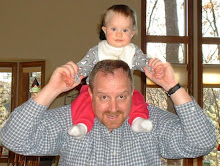Tuesday wasn't good for her either. I was going flying Tuesday morning and she was going to the doctor (finally). I got in about 1.3 hours of instrument work. Richard had me shoot 2 ILS approaches on top of some slow flight under the hood. Slow flight is very interesting. Everything happens a lot faster than you would think. The turning radius is much smaller so the airplane really turns (an the possibility of stalls) quick. An ILS approach is one of the most accurate approaches you can make. The ILS at McKinney takes you down to about 200 feet off of the ground. When I took my hood off on the first pass, it was a quick transition from looking at the instruments to getting the airplane ready to land and go missed. No time to be nervous about landings, just do it (Thanks Nike). The second one was a full stop landing, not a missed approach. When I took the hood off, I was lined up perfectly and still on the glide slope so my height was just right. Just slowed it up a little, add about 10 degrees of flaps and wait for the ground effects to kick in then put it down.
I only need 0.3 hours of instrument work before I fullfill my requirements to take my check ride. I need to do some more work on ground refrence manuevers, soft and short field landings then do a phase check with another instructor (a practice check ride). I'm hoping that I'll be ready around Christmas.
Part of the other reason for the late post was obviously my wife but also I had to take my daughter to her allergist, my computer died, was ressurrected, died again (really dead this time), got a new computer that died also and had to be returned. I finally got the new computer running but wasted a lot of time on it. I was able to retrieve all of my old emails. After getting throught all of this, we left on wednesday to spend Thanksgiving with my mother who lives about 5 hours away. All of the time we were gone, my wife was in terrible pain and now her whole arm is swolen. To make it even worse, my daughter got sick (new medicine) every night. Then we get home and we have to take my daughter to the doctor because her cough is getting worse. We find out that she is in the early stages of pnuemonia.
It gets better. I had to leave town Sunday for a business trip and my wife calls and said that she is going to have to have a MRI done to her arm and her sinuses are draining and her throat is scratchy. The only thing that would make this worse was the traffic on my trip. It usually takes me 4.5 - 5 hours. This time it was 6.5 hours.
I'm going to bed and when I wake up, this will all have been an episode of Dallas. RIGHT?
My-Elogbook
Todays Video is one I found about "Dangerous" landings. Let's just say that you wouldn't want to be a passenger on any of these flights. Pay attention to the last one and look at how short the runway is. He also touched down a little early on the displaced threshold.



